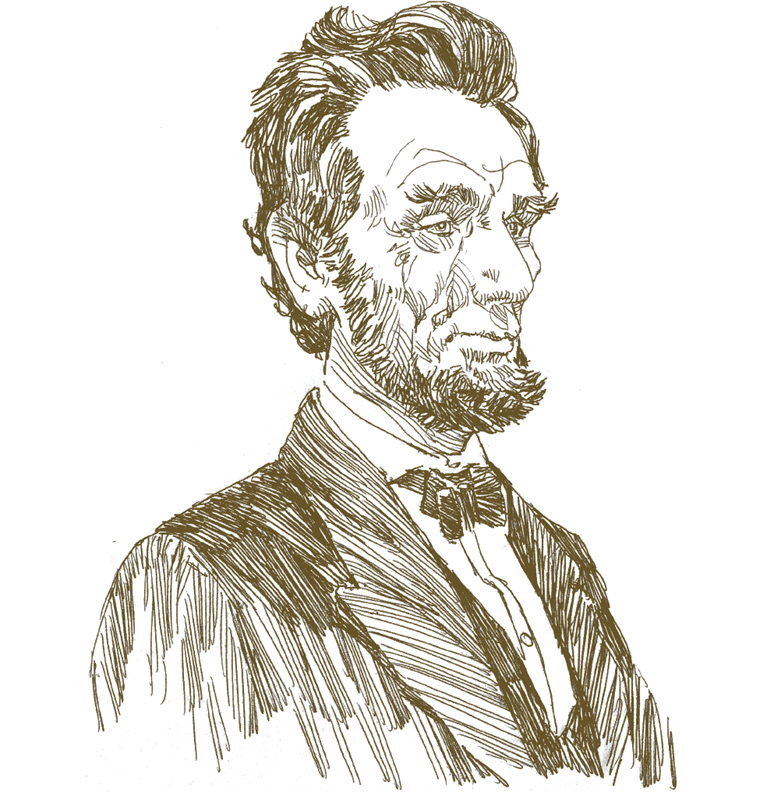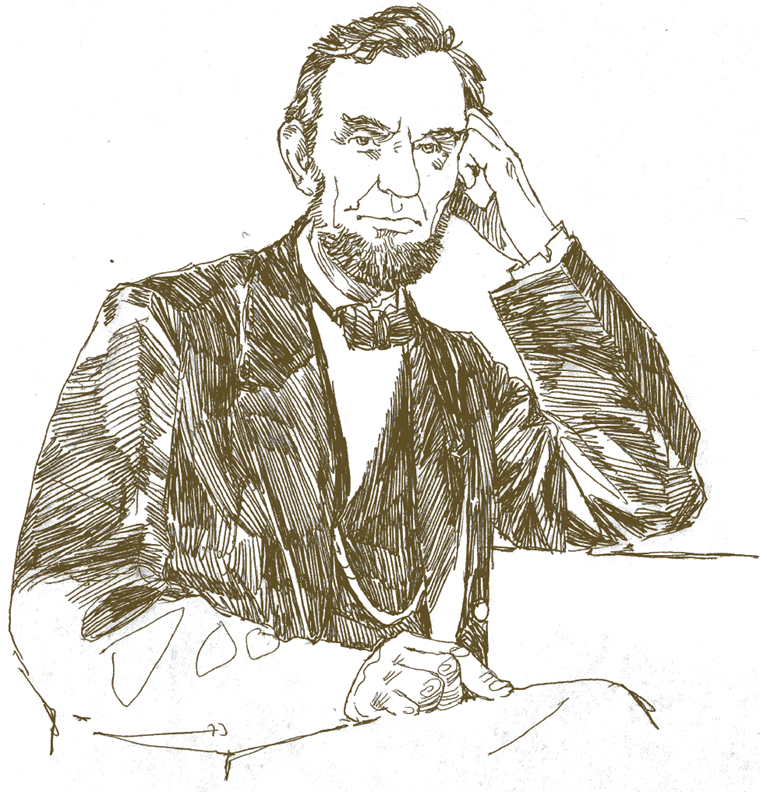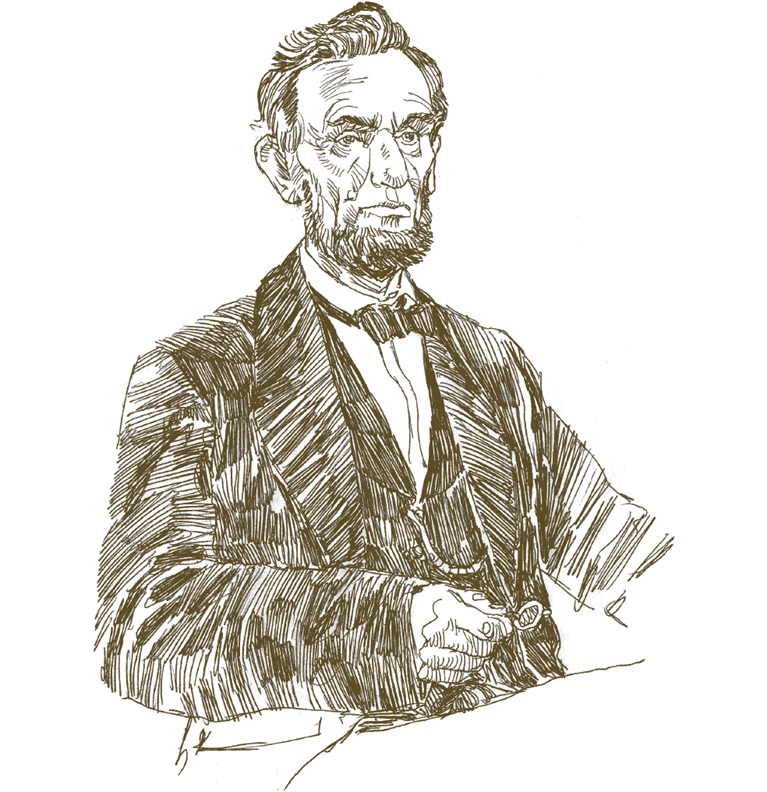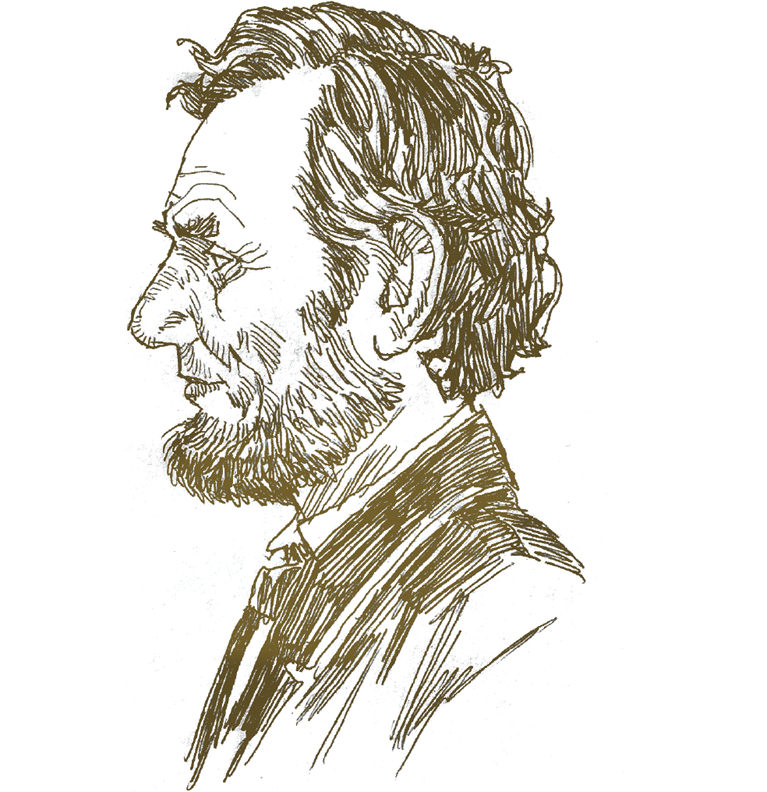Many years ago, I made a short film for the Harvard Business School about the lessons that Abraham Lincoln’s life offered for modern leaders. I interviewed a range of CEOs, asking them what they’d learned from the 16th president. Their responses were wide-ranging and profound; many continue to influence my work on leadership.
I was particularly struck by what A. G. Lafley, CEO of Procter & Gamble at the time, said about how leaders are made. He pointed to three main ingredients. The first is an individual’s strengths and weaknesses and the cumulative experience a person acquires walking his or her path. The second is that an individual recognizes a moment has arrived that demands his or her leadership. The third is that the individual has to consciously decide “to embrace the cause and get in the game.”
Making oneself into a courageous leader, in the way Lafley describes, is perilous, compelling, and exhausting work. It also is some of the most satisfying one can do, and it could not be more important today. Like the turbulent Civil War that Lincoln found himself at the center of, the early 21st century cries out for effective, decent leaders. People of purpose and commitment who want to make a positive difference and who choose to rise: first within themselves, by claiming their better selves, and then on the larger stage, by staking out the higher ground.
Abraham Lincoln has something to offer each of us right now as we try to craft lives of purpose, dignity, and impact. Are you ready to hear the call to action contained in his story?
Discernment
Lincoln had humble roots and no formal education. By age 25, he also had a growing interest in politics, and needed a career to feed that interest while helping him improve his lot. Lincoln began borrowing the law books of a mentor from the Illinois state militia who was an accomplished attorney and state legislator. He studied by himself. A neighbor remembered Lincoln “was so absorbed that people said he was crazy. Sometimes [while he was studying he] did not notice people when he met them.”

We do not know exactly how Lincoln sustained his determination to succeed. What we do know is that from an early age he practiced great discipline in relation to the things that mattered. Some of the discipline was focused on practical ends: toward preparing himself to be a lawyer or bettering himself intellectually. Some of it was directed at managing his emotions. As his prospects expanded, he worked to comport himself with greater dignity and forbearance.
He earned a reputation as an attorney who was skilled before a jury. Not because he mastered the laws of evidence or finer points of precedents; he did neither. Instead, this reputation rested on his ability to concentrate a jury’s attention on the few essential points of a case while conceding the less important issues to his opponent.
Lincoln’s ability to relate to juries provides a useful lesson about discernment. Leaders trying to accomplish a worthy mission have to cultivate the ability to identify the one, two, or three essential issues facing them at a given moment. It is never five or ten. It is always one or two—maybe three—issues that really matter. Having identified these, leaders must let the remaining concerns go, either by giving themselves permission to turn their attention away from all that is not central to their purpose or by handing peripheral issues to others, including an adversary. Being able to do this—to concentrate on the most important issues while relinquishing the rest—depends on a leader’s willingness to recognize two things: first, he or she cannot do it all, and second, by saying no to that which is not mission critical, one is actually saying yes to that which is.
Disappointment
Lincoln, like many other leaders, didn’t blaze onto the larger stage at a young age. And even when he began to build a legal and political career, his path was marked by as many failures as successes. The making of courageous leaders is rarely swift and smooth. Indeed, the setbacks and the times that Lincoln spent not being able to gratify his ambitions were important ingredients in the wisdom, resilience, and empathy that he nurtured and then used so successfully.

In 1846, for example, Lincoln was elected to the US House of Representatives by a large majority. During his first year in Washington, he devoted most of his attention to attacking Democratic president James Polk’s prosecution of the Mexican-American War. When his term in office ended in March 1849, Lincoln returned to Illinois. There, he discovered that his political stock was lower than when he had left. His party had failed to elect its candidate to the congressional seat that Lincoln was vacating, and many of his supporters blamed him and his unpopular position on the Mexican-American War for the defeat. Lincoln fell into a depression.
Although he returned to the practice of law, Lincoln found the allure of politics irresistible and set about helping to organize the young Republican Party in the state of Illinois. The central element of the Republican platform was opposition to slavery’s extension. Within Illinois, Lincoln became a leading spokesman for this position (while accepting its legality where it already existed). In contrast, many Democrats, such as the US senator from Illinois, Stephen Douglas, supported slavery’s expansion.
In 1858, Lincoln challenged Douglas for his US Senate seat. The race attracted national interest, partly because Illinois was regarded as a battleground state—not only in skirmishes between Democrats and Republicans, but also between supporters and opponents of slavery. Lincoln lost, and was deeply disappointed.
Triumph and tragedy
Late in 1859, newspapers began mentioning Lincoln as a potential presidential candidate in the 1860 election. At the Republican Convention in Chicago, no candidate won a majority of the votes on the first ballot. Support for Lincoln grew as the convention progressed, and on the third ballot, cast on May 18, he won 364 of 466 possible votes, becoming the Republican nominee for president. A month later, the Democrats met to select a nominee. Party delegates split, with Northern members backing Stephen Douglas and Southern delegates supporting John Breckinridge. This splintering of the Democratic party greatly increased the odds of a Republican victory in the general election on November 6.

At about two in the morning on November 7, Lincoln learned that he’d been elected president. As he walked back home in the wee hours, Lincoln did not exult. Recalling the moment two years later, he said he slept little before dawn. “I then felt, as I never had before, the responsibility that was upon me.”
Lincoln’s election precipitated a national crisis. Convinced that the president-elect would try to abolish slavery, many Southern leaders believed the only way to protect the institution—and the way of life that rested on it—was to leave the United States and establish their own country. In early February 1861, representatives of South Carolina, Mississippi, Florida, Alabama, Georgia, Louisiana, and Texas met in Montgomery, Alabama, to form a new nation, the Confederate States of America, and adopt a constitution.
On March 4, 1861, before a crowd of 50,000, Lincoln delivered his inaugural address on the steps of the US Capitol. He knew the fate of the upper Southern states of Virginia, Arkansas, Tennessee, and North Carolina, which had not yet seceded, might depend on what he said, and he took pains to reassure Southerners that he would leave slavery alone in the states where it already existed.
In spite of Lincoln’s efforts, tensions between North and South escalated. These came to a head with the president’s decision on Fort Sumter, a federal garrison in the harbor of Charleston, South Carolina. Government soldiers inside the fort were running out of food. But sending provisions into what was now hostile territory risked Confederate attack. For weeks, Lincoln agonized over what to do. He did not want his administration to appear weak by not resupplying the fort and thus effectively surrendering it. But he also did not want to initiate open warfare.
After many sleepless nights and conversations with his cabinet, Lincoln ordered government forces to sail for Charleston Harbor with food, but no arms. On April 12, 1861, with the federal fleet nearby, Confederates bombarded the garrison with shells and gunfire. Within 36 hours, the commanding officer of the fort surrendered to Southern forces. The Civil War had begun.
Loneliness
From the start, the Civil War defied Americans’ expectations. Following Fort Sumter, for example, many Northerners and Southerners believed that victory was imminent for their respective side, and that few lives would be lost. But after the Battle of Bull Run near Manassas, Virginia, in July 1861, in which almost 5,000 Union (northern) and Confederate troops were killed or wounded, it became clear that the war would be longer and bloodier than most had anticipated. The day after the battle, Lincoln called for 500,000 volunteers; within days, Congress authorized an additional half million troops.

By late 1861, the Union’s general in chief, George McClellan, had reorganized troops around Washington, but then refused to move them south to attack Confederate forces. His Army of the Potomac—some 120,000-men strong—remained in and near the capital without seeing any kind of battle.
Worried about the general’s inaction, Lincoln began visiting McClellan at home during the evenings. On November 13, the president and one of his secretaries, John Hay, called at the general’s house. McClellan was not in, and the two decided to wait. When the general arrived an hour later, he hurried upstairs, ignoring his visitors. The president and his secretary remained where they were for 30 minutes before Lincoln sent word up that he was still downstairs. McClellan sent his own message back, saying he had gone to bed. Hay was appalled at the general’s insolence, voicing this to the president as they walked back to the White House. “It was better at this time,” Lincoln responded, “not to be making points of etiquette & personal dignity.” As he came to understand, not all issues—including personal slights and insults—that came before him were of equal importance. Lincoln realized he had to keep his eye (not to mention his emotional energy) on what was central to his mission and not become distracted by what we would today label “sweating the small stuff.”
The president began to teach himself military strategy, borrowing textbooks from the Library of Congress, poring over field reports, and conferring with military officers. As he did this, it became clear to him that a Union victory depended on the North’s ability to exploit its greater resources—human and economic—in a series of interrelated attacks on the Confederacy. But how could he make his generals execute this strategy? McClellan effectively ignored Lincoln’s orders. Other commanders, often acting without top-level coordination, followed their own plans or simply waited.
It was a lonely time. Some of Lincoln’s loneliness flowed from the authority and responsibility he carried. The president knew that saving the Union rested critically on his shoulders—on ability to simultaneously lead on many fronts against many obstacles. This heavy realization isolated Lincoln from family, friends, and colleagues. Not only could these people not fully grasp what he was dealing with; not only did he have to be careful about entrusting his thoughts and feelings to others; but Lincoln also likely understood that no one else could travel the internal path he was taking as a leader. None could see the things he was discovering about himself and his impact, see the ways he was changing as the war stretched on, or, finally, experience his doubts and fears. These were essential aspects of his leadership, and they were his alone.
Virtually every leader will know real loneliness. This is intrinsic to the work; it can rarely be avoided or wiped away by specific action. Instead, effective leaders learn to accept such moments of isolation, using them in service to their larger mission by keeping their own counsel, reflecting carefully on a particular issue, or grappling with their thoughts and feelings.
Gettysburg
In early July 1863, the Army of the Potomac, now under the leadership of General George Meade, won a decisive battle in Gettysburg, Pennsylvania, repulsing Robert E. Lee’s Army of Northern Virginia as it attempted to invade the North. It was a critical victory that came at a fearsome cost. At the opening of the confrontation, a total of 160,000 troops from both sides had poured into the Pennsylvania hamlet. When the smoke cleared three days later, 51,000 Americans were dead, wounded, or missing; 23,000 of these men were federal soldiers, 28,000 were Confederates.
Nonetheless, peace did not come. The war raged on—with seemingly no end in sight. Why, the president asked himself, could he not bring the conflict to a close? Why was it proving so violent? In early November, when he received an invitation to deliver “a few appropriate remarks” at the dedication of a new national cemetery at Gettysburg, Lincoln saw an opportunity to give voice to the larger issues he’d been wrestling with. His remarks totaled only 272 words. It took him less than three minutes to deliver them:
Four score and seven years ago our fathers brought forth on this continent, a new nation, conceived in Liberty, and dedicated to the proposition that all men are created equal. Now we are engaged in a great civil war, testing whether that nation, or any nation so conceived and so dedicated, can long endure. We are met on a great battle-field of that war. We have come to dedicate a portion of that field, as a final resting place for those who here gave their lives that that nation might live. It is altogether fitting and proper that we should do this. But, in a larger sense, we can not dedicate—we can not consecrate—we can not hallow—this ground. The brave men, living and dead, who struggled here, have consecrated it, far above our poor power to add or detract. The world will little note, nor long remember what we say here, but it can never forget what they did here. It is for us the living, rather, to be dedicated here to the unfinished work which they who fought here have thus far so nobly advanced. It is rather for us to be here dedicated to the great task remaining before us—that from these honored dead we take increased devotion to that cause for which they gave the last full measure of devotion—that we here highly resolve that these dead shall not have died in vain—that this nation, under God, shall have a new birth of freedom—and that government of the people, by the people, for the people, shall not perish from the earth.
Lincoln’s speech is a first-rate example of a leader framing the stakes of the change. In hindsight, we can see that he used the dedication ceremony to connect the continuing turbulence—the Civil War—with the history and mission of the enterprise—the American polity and its central proposition. He then led his audience to the present moment, relating their action to “the unfinished work” in which they and all other Americans were involved. He laid down the gauntlet for every citizen who supported the Union: “it is rather for us to be here dedicated to the great task remaining before us—that from these honored dead we take increased devotion to that cause for which they gave the last full measure of devotion.”

In saying this, Lincoln presented the trade-offs of committing to the mission: a great civil war, a testing struggle, and thousands of deaths. He concluded by stating that as formidable as these costs were, they were the price of a mighty end, one with lasting significance: “that this nation, under God, shall have a new birth of freedom—and that government of the people, by the people, for the people, shall not perish from the earth.”
Every modern leader navigating through a crisis can learn from the Gettysburg Address. We are unlikely to approach the eloquence and power of Lincoln’s language. But we can take from his leadership the critical importance of framing the stakes of a particular moment. This means connecting current change efforts to the history and future of the enterprise, locating these efforts in the arc of ongoing events, explaining each stakeholder’s role in the process, identifying the specific trade-offs of making the change, and understanding these costs in relation to the ultimate goal. The more turbulent the world becomes in the early 21st century, the more vital it is for leaders to interpret and frame this volatility in relation to a worthy purpose.
Transformational change
Lincoln had no silver bullets to save the Union. This was difficult to accept. But as the war stretched on, he began to understand that the complexity of the conflict and the magnitude of its stakes made a single, clear-cut way to end it virtually impossible.
This is an insight for today’s leaders. We are under pressure to move fast, leap tall buildings in a single bound, and make a big impact. But the reality of trying to accomplish something real and good gives lie to the seductive notion that there is one simple solution. Almost anything along our life journeys that is worth investing in, worth fighting for, and worth summoning our best selves for has no silver bullet. The bigger the issue, the less likely it is that a leader can resolve it in one or two swift strokes. Understanding this means abandoning the quest for the single definitive answer. Letting go of this quest frees leaders—emotionally and practically—to focus on the many possible approaches and actions needed to make a meaningful difference.
In the aftermath of the battle at Gettysburg, appalled by the human carnage, many Northerners thought the government should stop fighting and seek a settlement with the rebel states, one that recognized the legality of slavery. Against this backdrop, in mid-1863, Lincoln accepted an invitation from his old friend James Conkling to address a large meeting of Union supporters in Springfield, Illinois. As the speech grew closer, pressing responsibilities prevented the president from leaving Washington. So instead of returning to his hometown, he wrote a letter for Conkling to present at the gathering.
The letter, which was published in newspapers across the country, laid out the principal arguments of the peace faction and Lincoln’s careful response to these. Looking back, we can see that Lincoln was doing more than making the case for his policies. As any serious leader engaged in large-scale change must, he was also trying to keep the relevant lines of communication open. He understood that widespread transformation always unleashes waves of collective fear, discontent, and doubt—emotions that often translate into vocal, and potentially more destructive, opposition. He also knew that if left unacknowledged, adversaries have the power to derail even the worthiest attempts at reform, and thus it is a leader’s responsibility to identify and, when necessary, neutralize his or her most powerful critics.
But how is the person at the center of the change to do this without appearing weak, creating additional enemies, or potentially legitimating the very attacks he or she is trying to mitigate? These are complicated issues, so it is not surprising that leaders often avoid head-on engagement with their challengers, hoping instead that the rallying cry of the mission and the enthusiasm of supporters will overwhelm naysayers.
This is a risky strategy, especially when the stakes are high. It was to Lincoln’s credit that he understood the power of Northern elites, who did not want to fight a war to end slavery. The president also realized that to defuse this “fire in the rear,” he had to speak directly to the American public, and he had to do this by addressing the specific arguments his opponents were making against him. Finally, he had to explain his actions in terms of his larger purpose. Lincoln did all of this in the speech for James Conkling. Seen from the perspective of a change leader effectively communicating with relevant stakeholders and trying to alleviate serious threats to the broader transformation, the president’s letter was a tour de force.
Willpower
As the summer of 1864 wore on, without a Union military victory in sight, Northern morale collapsed. Politicians and journalists called for an immediate end to the war, with many predicting that Lincoln would lose the upcoming presidential election. “The people are wild for Peace,” said New York politician Thurlow Weed. They won’t support the president, he added, because they are told he “will only listen to terms of peace on condition [that] slavery be abandoned.”

The commander in chief began to waver. Perhaps, he told himself as he paced the White House hallway late at night, he should enter into peace talks with Southern leaders. On August 19, he drafted a potentially momentous letter to a Democratic politician and newspaper editor, ending the communication with this proposition: “If Jefferson Davis wishes . . . to know what I would do if he were to offer peace and re-union, saying nothing about slavery, let him try me.”
Having written these words, Lincoln paused. He did not send the letter; instead, he stored it in his desk while he thought about what to do. Two days later, when the escaped slave and abolitionist Frederick Douglass visited Lincoln at the White House to discuss helping slaves reach Union military lines, the president read the letter aloud to him. The black activist strongly urged the chief executive to keep it to himself. If he sent it, Douglass said, the missive would be interpreted “as a complete surrender of your anti-slavery policy, and do you serious damage.”
Lincoln returned the letter to his files. With renewed confidence, the president decided emancipation would remain an essential condition of any negotiations with the Confederacy. For a few days during the long, hot summer of 1864, Lincoln had considered backing away from his mission. But in the end—at the moment it really mattered—he did not. He held the line.
Historians and biographers have pointed to a number of Lincoln’s strengths and their role in his leadership. But one of the most significant of these strengths is not often mentioned, and this is that Lincoln simply kept going. Once he made a crucial decision, he saw it through, even when virtually everything around him seemed stacked against such a commitment. This adherence was not the result of stubbornness or self-righteousness. Rather, it came from the care that Lincoln exercised in making choices, including the slowness with which he acted when the stakes were high; from his growing depth as a moral actor; and from his sheer will to get up each morning and do what he could in service of his mission.
The Civil War ended more than 150 years ago. But we, it seems, are not finished with the man who led the country through it. Not by a long shot. Lincoln’s journey was one of learning by doing, ongoing commitment to bettering himself, keen intelligence harnessed to equally acute emotional awareness, and the moral seriousness into which he grew as he attained immense power. It was also an all-too-human path marked by setbacks, derailments, and disappointments.
Abraham Lincoln was made into an effective leader—first from the inside out and then from the outside in—as he developed and changed throughout his life. That, as president, he refused to ignore the larger consequences of his actions on men and women who had little or no agency, that he saw beyond the immediate moment and owned the responsibility of affecting a vast future, and that he rejected an ethical callousness about the choices he made are demonstrations of leadership that we yearn for today. May all who aspire to lead with worth and dignity learn from the life and leadership of Abraham Lincoln.


